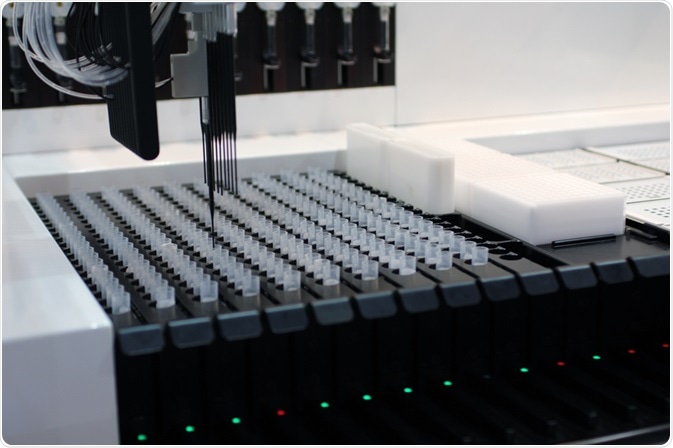Liquid handling robots are automated devices that dispense and sample liquids in laboratory settings. Such systems include automated pipetting systems and microplate washers. These machines reduce the need for manual work in preparation for high throughput screening or sequencing, liquid weighing, sample preparation, and bioassays, while still retaining high precision.
 Image Credit: Goran Bogicevic/Shutterstock.com
Image Credit: Goran Bogicevic/Shutterstock.com
Types of liquid handling robots
In general, liquid handling robots follow the same architecture:
- A control center controls the moving robot,
- The washing station cleans dispensing heads - to ensure sample safety,
- The dispensing heads dispel the liquid onto the sample,
- The sensors oversee the status of the dispensing part - to enable the control center to feedback, if necessary
The number of arms can vary depending on the robot. The dispensing heads can differ depending on the task, with the most commonly used ones being pins, tips, and needles. Most robots are restricted to movement in the x and y plane, but some can include a z drive.
Liquid handing robots are increasing in use and accessibility in industrial and academic settings. Volumes which can be handled range from roughly 0.5 µl to 5 L and are applicable to most experimental procedures. However, the sample volume is one of the main considerations when investing in one.
The robots are capable of accurately and quickly pipetting liquids as small as 100 nL, which minimizes the cost and volume of reagents used. Liquid handling robots are generally either moveable substrates or fixed substrate types, which relates to substrate movement.
Liquid handling robots are commonly integrated with liquid chromatographic systems or built-in with other systems. For example, liquid handling robots can be coupled so as to automatically feed samples to heating or cooling systems, shaking systems, or other peripheral laboratory equipment, depending on the target application.
Critically, automated systems have the ability to program start and stop functions and to program several sequential steps that are needed during preparation or assays.
The types of work carried out by liquid handling robots is different for each make and model. Some robots are well suited for serial dilutions and preparing and dispensing into plates with 96, 384, or 1536 wells. Other robots are restricted to one or two channels, but are useful for extraction of nucleic acids or preparation for PCR reactions.
Applications
Biological research
Some of the areas benefitting the most from liquid handling robots are biological research and drug development laboratories, where use of automated systems can help reduce contamination and smoothly carry out the many sampling, mixing, and pipetting steps involved in such research.
Molecular biology assays
Other research areas include antibody-based assays, molecular assays, and crystallography. In some cases, the automated systems are better than manual options. For example, PCR results are influenced by the accuracy and reproducibility of pipetting due to the massive amplification differences it can create. Here, accuracy and reproducibility are difficult to guarantee consistency for with manual pipetting but easily offered by liquid handling systems.
Epigenetics and genetics
Liquid handling robots have become particularly popular among epigenetics and genetics studies. Several second-generation sequencing technologies have been developed along with automated systems, such as for PCR reaction setup stages and the liquid handling and immunoprecipitation stages of ChIP analysis.
As such, liquid handling robots offer a viable solution to enable more epigenetic-based treatments of diseases, such as leukemia and lymphoma. However, robotics workstations are priced at as much as USD 250,000, and can therefore be inaccessible to most institutions. Sufficient space and limited training opportunities are also main challenges to increased use of liquid handling robots.
Pharmaceutical industries
Pharmaceutical industries represent a third major user of liquid handling robots. Drug development can involve the screening of millions of compounds for potential drug candidates to fight one of the many diseases.
Screening of so many compounds is not only time consuming, but can be expensive if fragile bioactive assay samples are used. The ability of liquid handling robots to accurately control the volume of liquid dispensed can save companies significant materials cost.
Further Reading
Last Updated: Feb 2, 2021